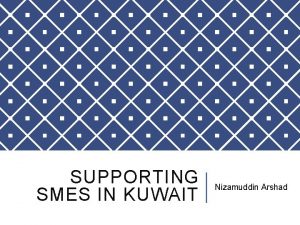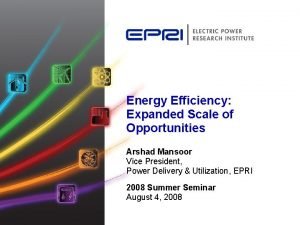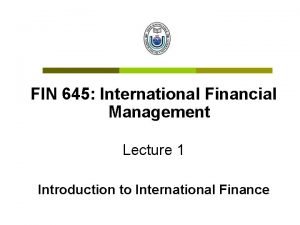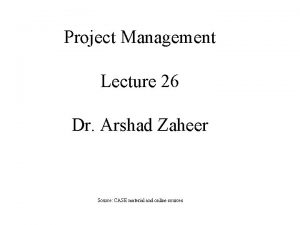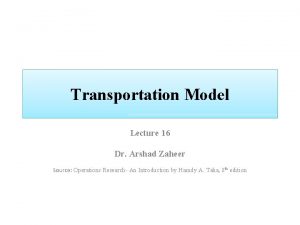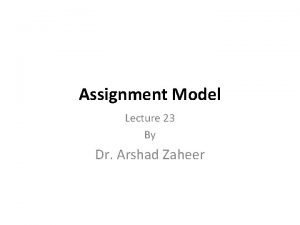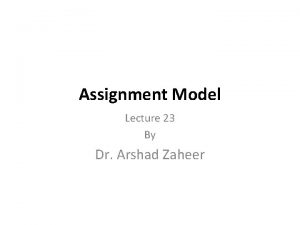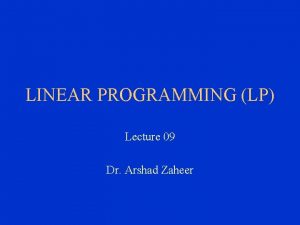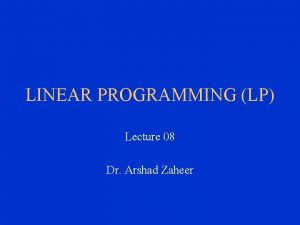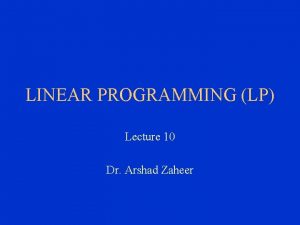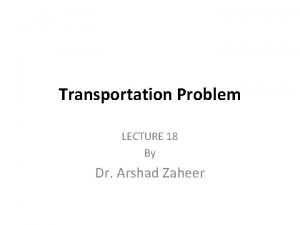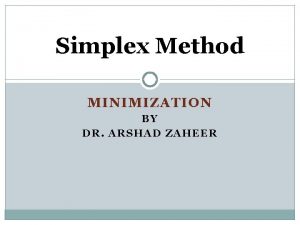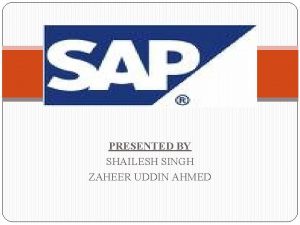Project Management Lecture 28 Dr Arshad Zaheer Source






























- Slides: 30

Project Management Lecture 28 Dr. Arshad Zaheer Source: CASE material and online sources

Recap § § § § § PERT and CPM Framework of PERT/CPM Terminology Drawing Network Diagrams Calculation of expected time Identification of critical path Gantt charts, Resource loading and leveling Work Breakdown Structures Linear Responsibility Charts

Outline § § § Financial Analysis of Projects Time value of money Payback Period Net Present Value (NPV) Benefit Cost Ratio (BCR) Internal Rate of Return (IRR)

Financial Analysis of Projects

Time Value of Money • Conceptually, “time value of money” means that the value of a sum of money received today is more than its value received after some time. Conversely, the sum of money received in future is less valuable than it is today. • In other words, the present worth of a rupee received after some time will be less than a rupee received today. Since a rupee received today has more value, individuals, as rational human beings, would naturally prefer current receipt to future receipts.

Techniques • In order to have logical and meaningful comparisons between cash flows that result in different time periods it is necessary to convert the sums of money to a common point in time. There are two techniques for doing this: – Compounding F = P (1 + I)n – Discounting P=

Techniques (Contd) • Compounding Technique • Interest is compounded when the amount earned on an initial deposit (the initial principal) becomes part of the principal at the end of first compounding period. The term principal refers to the amount of money on which interest is received.

TIME VALUE OF MONEY Money can earn interest during the time it is invested, a future return is worth less at the present time. Or An amount of dollar invested now will be worth more when the principal and its accumulated interest are received n years from now

n F=P(1+i) F P i n is the future value of the investment is the present value of the investment is the annual interest rate is the number of years.

Example • Investment = $ 1, 000 (P) • Interest (i) = 10 % a year • Compounding annually • Time = 1 year F=P(1+i)n =$1, 000 (1. 10)1 =$1, 100 (n)

Now If investment is for 2 years F=P(1+i)n =$1, 000 (1. 10)2 =$1, 210 We can also calculate 2 years compound interest, by investing 1 st years principal and interest. F=P(1+i)n =$1, 100 (1. 10)1 =$1, 210

Quarterly Compounding Interest is paid at the end of each quarter i. e. , four times a year Example • • Investment = $ 1, 000 Interest = 10 % a year Compounding quarterly Time = 2 year F=P(1+i/4)4(2) =1, 000(1. 025)8 =$1, 218. 4

Monthly Compounding Interest is paid at end of each month, twelve times a year Example • • Investment = $ 1, 000 Interest = 10 % a year Compounding monthly Time = 2 year F=P(1+i/12)12(2) =1, 000(1. 00833)24 =$1, 220. 3

Daily Compounding There are 360 compound periods per year Example • • Investment = $ 1, 000 Interest = 10 % a year Compounding id done daily Time = 2 year F=P(1+i/360)360(2) =1, 000(1+0. 10/360)720 =$1, 221. 4

DISCOUNTING If the future value of an investment is known we can easily derive its present value, given an interest rate and the number of compounding periods. P=F/(1+i)n Example How much money to invest now at 10% compounded annually to receive $1, 000 in 5 years. P=$1, 000/(1. 10)5 =1, 000/1. 611 =$620. 7

Example How much money to invest now at 10% compounded quarterly to receive $1, 000 in 5 years. P=$1, 000/(1. 025)20 =$ 610. 3 --------------------------------------

NET PRESENT VALUE The net present value method requires that all cash flows be discounted to their present value, using the firm’s required rate of return. NPV= (A /(1+i) -C t t) 0 NPV takes into account the time value of money, and regardless of the pattern of cash flows, a single net present value is calculated.

Example Cash flows Years 0 1 2 3 Project A -$2, 500 $1, 000 $1, 500 $1, 000 Project B -$2, 500 -$1, 000 $2, 500 $2, 000 • Project A requires initial investment of $2, 500 • Project B requires initial investment of $2, 500 an additional cash outlay of $1000 in the first year • Required rate of return is 10%

NPVA= -2, 500+1, 000(0. 9091)+1, 500(0. 8264) +1, 000(0. 7513) =$ 400 NPVB= -2, 500 -1, 000(0. 9091)+2, 500(0. 8264) +2, 000(0. 7513) =$ 160 Since the NPV of project A is larger so it is better

Profitability index • The relationship of benefits to the cost of undertaking is provided by the profitability index, or the benefit-cost ratio • The ratio of aggregate discounted benefits and aggregate discounted costs Profitability Index= At / (1+k)t C 0

Profitability Index = BCRA= 1, 000(0. 9091)+1, 500(0. 8264)+1, 000(0. 7513) 2500 = 909. 1+1239. 6 + 751. 3 2500 =2900 = 1. 16 2500

Profitability Index = BCRB= 2, 500(0. 8264) +2, 000(0. 7513) -2, 500 -1, 000(0. 9091) = 2066 +1502. 6 3409. 1 = 1. 046

Internal Rate Of Return The IRR of return for an investment is the rate of return (interest rate) that makes the present value of cash flow equal to the cost of the investment. or The IRR of an investment is the discount rate that makes the NPV of the investment equal to zero. IRR = LDR + (HDR – LDR)NPV of LDR – NPV of HDR

PAYBACK PERIOD • Used when firms are concerned with the number of years required to recover the initial outlay of an investment. The payback period is used to evaluate the feasibility of projects in such cases. • Payback period is found in two ways • Conventional payback • Discounted payback

Conventional payback The payback period is simply obtained by counting the number of years it takes for cash flow to equal the initial investment

Discounted payback This method requires that the cash flow be discounted using the required rate of return, before they are added up to equal the initial investment WHICH ONE IS GREATER?

Payback Period (Contd) Project cash flows ($) Year 0 1 2 3 4 5 A -2, 400 600 600 600 B -2, 400 800 800 800 C -2, 400 500 700 900 1, 100 1, 300 Conventional payback (years): 4. 0 3. 3 Discounted payback (years) 5. 4 3. 8 4. 1 Net present value(i=10%): -126 633 868

Discounted Cash Flows Year A B C 0 -2, 400 i=10% -2, 400 1 600 800 500 0. 909 545. 45 727. 27 454. 55 2 600 800 700 0. 826 495. 87 661. 16 578. 51 3 600 800 900 0. 751 450. 79 601. 05 676. 18 4 600 800 1100 0. 683 409. 81 546. 41 751. 31 5 600 800 1300 0. 621 372. 55 496. 74 807. 2 NPV -126 633 868 BCR 0. 95 1. 26 1. 36

Discounted Cash Flows Year A A 0 -2, 400 i=6% -2, 400 1 600 0. 943396 566. 04 2 600 0. 889996 534. 00 3 600 0. 839619 503. 77 4 600 0. 792094 475. 26 5 600 0. 747258 448. 35 NPV (6%) 127

IRR (Project A) NPV (10%) = -126 NPV (6%) = 127 IRR = LDR + (HDR – LDR)NPV of LDR – NPV of HDR = 6 + (10 – 6)*127 – (-126) = 8%
 Sri zaheer
Sri zaheer /forum/ qazi
/forum/ qazi Zaheer ayub baig
Zaheer ayub baig Fenoina
Fenoina Occupational asthma
Occupational asthma Dr syed arshad
Dr syed arshad New kuwait
New kuwait Arshad mansoor
Arshad mansoor Arshad habib
Arshad habib Arshad usmani
Arshad usmani Dr arshad ali khan
Dr arshad ali khan 01:640:244 lecture notes - lecture 15: plat, idah, farad
01:640:244 lecture notes - lecture 15: plat, idah, farad Project procurement management lecture notes
Project procurement management lecture notes 4ps of project management
4ps of project management Project management lecture notes doc
Project management lecture notes doc Project cost management lecture notes
Project cost management lecture notes Project management lecture
Project management lecture Project planning and management lecture notes ppt
Project planning and management lecture notes ppt Introduction for project
Introduction for project Open source ppm
Open source ppm The role of project management in achieving project success
The role of project management in achieving project success Process discriminants in software project management
Process discriminants in software project management Reducing project duration in project management
Reducing project duration in project management Introduction to project management kathy schwalbe
Introduction to project management kathy schwalbe Software project evaluation
Software project evaluation Types of project audit in project management
Types of project audit in project management Ms project agile planning
Ms project agile planning Varieties of project termination
Varieties of project termination Strategic management lecture
Strategic management lecture Financial management lecture
Financial management lecture Public sector accounting lecture notes in kenya
Public sector accounting lecture notes in kenya






